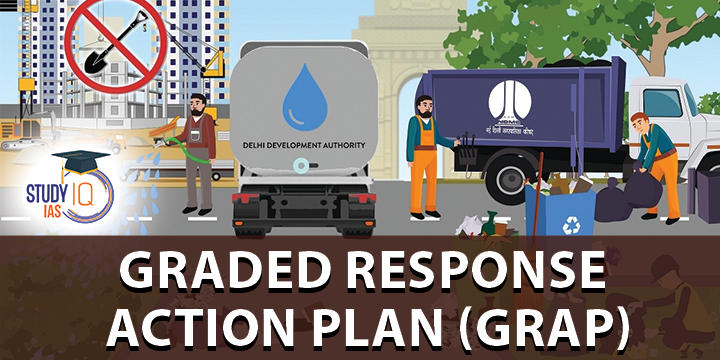Table of Contents
Graded Response Action Plan Delhi
About: Graded Response Action Plan is a set of emergency measures that kick in to prevent further deterioration of air quality once it reaches a certain threshold.
Origin:
The Graded Response Action Plan was first notified in January 2017 by the Ministry of Environment, Forest and Climate Change (MoEFCC).
This was based on a plan that was submitted by the Central Pollution Control Board (CPCB) in November 2016.
Implementation:
According to the 2017 notification, the task of implementing the Graded Response Action Plan was with the now dissolved Environment Pollution (Prevention and Control) Authority for the NCR.
From 2021 onwards, the GRAP is being implemented by the CAQM.
The CAQM has constituted a sub-committee for the operationalization of the GRAP, which is required to meet frequently to issue orders to invoke the GRAP.
Enforcement: Measures under the various stages of Graded Response Action Plan are to be enforced by the pollution control boards of the NCR states and the concerned departments and agencies, including the traffic police, the Transport Department and road owning and construction agencies.
Stages and Measures:
The Graded Response Action Plan constitutes four stages which are activated based on the Air Quality Index (AQI) value.
Actions under Stages II, III and IV will be invoked three days in advance of the AQI reaching the projected level.
Measures being imposed under the previous categories will continue even when the subsequent category is activated, that is, if measures under Stage-2 are activated, measures under Stage-1 will continue to remain in place.
For AQI values, Commission of Air Quality Management (CAQM) is relying on the forecasts by the Indian Institute of Tropical Meteorology (IITM) and the India Meteorological Department (IMD).
| Stage | Triggering AQI value | Measures |
| Stage 1 | ‘poor’ category
(201 to 300) |
|
| Stage 2 | ‘very poor’ category
(301 to 400) |
|
| Stage 3 | ‘severe’ category
(401 to 450) |
|
| Stage 4 | ‘severe -’ category
(above 450) |
|
Graded Response Action Plan Background
- The order came after Delhi’s AQI deteriorated to be in the ‘poor’ category.
- Other parts of the NCR, including Gurgaon, Noida and Greater Noida, also recorded ‘poor’ air quality.
How is the Graded Response Action Plan different this year

Graded Response Action Plan: Other Measures being Considered?
- Under the ‘severe -’ category, State governments may consider additional emergency measures like the closure of schools, plying of vehicles on an odd-even basis, and decide on allowing public, municipal and private offices to work on 50% strength and the rest to work from home.
Commission for Air Quality Management (CAQM)
- Establishment:
- It is a statutory body formed under the Commission for Air Quality Management in National Capital Region and Adjoining Areas, Act 2021.
- The CAQM has replaced the Environment Pollution (Prevention and Control) Authority (EPCA) which was appointed by the SC in 1998 and had been active for 22 years.
- Objective: The Commission basically aims at better coordination, research, identification, and resolution of problems related to air quality in NCR and adjoining areas.
- Jurisdiction: Over the NCR, including areas in Haryana, Punjab, Uttar Pradesh and Rajasthan
- Parent authority: The Ministry of Environment, Forests and Climate Change.
- Powers and functions:
- The Commission will supersede bodies such as the central and state pollution control boards of Delhi, Punjab, Haryana, UP and Rajasthan.
- Power to restrict industries in any area, conduct random inspections of any premises including factories. It may also shut down an industry or cut its water and power supply in case of non-compliance.
- Commission of Air Quality Management will also be monitoring the actions taken by the states to prevent stubble burning.
- The orders and directions of the CAQM will prevail in case of any conflict between directions issued by the State governments and the Commission of Air Quality Management.
- Composition:
- It is a permanent body and will have over 20 members.
- To be chaired by a government official of the rank of Secretary or Chief Secretary.





















 WhatsApp
WhatsApp